How LED Lamp Manufacturers Deceive Buyers
The popularity of LED lighting is growing. The number of Russian manufacturers of LED lamps is approaching a hundred. Unfortunately, some of them do not hesitate to deceive the buyer, for one discrediting other manufacturers. After all, the buyer unsuccessfully buying some lamps, then he will be afraid to buy others.
Here are two lamps "housekeeper." Judging by the pictures, the buyer should understand that they consume 5 watts, and shine like 60-watt incandescent bulbs.
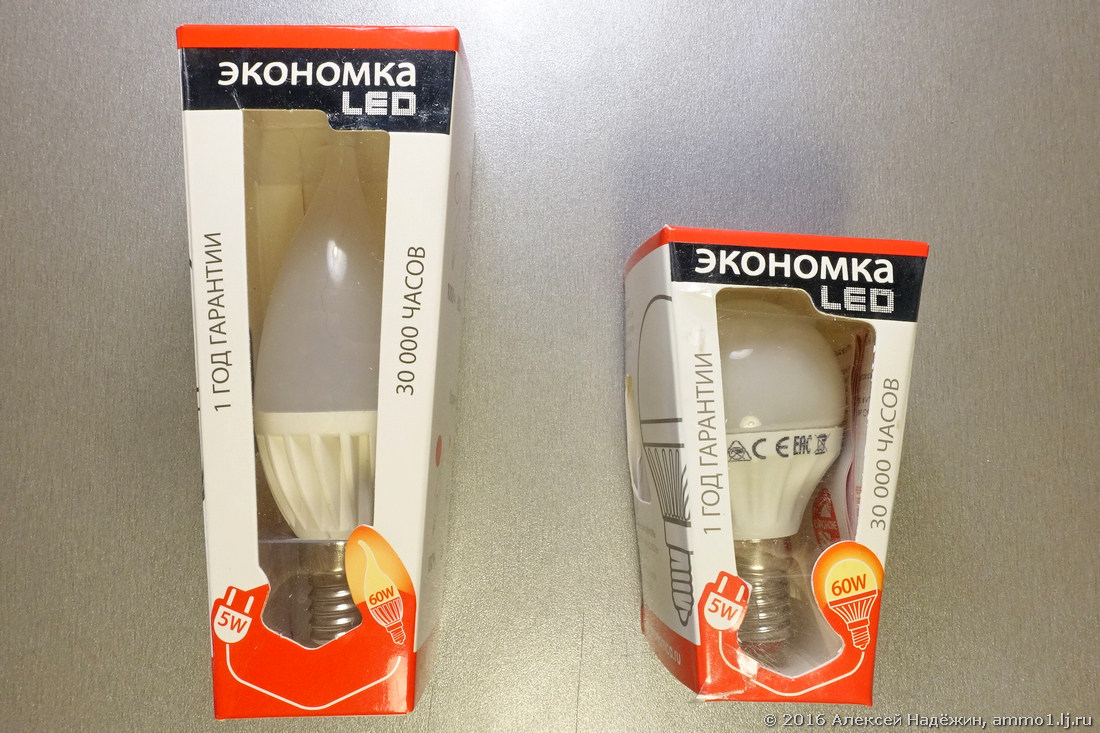
')
Cheating begins already in the information on the package. On both lamps in small print it is indicated: “Luminous flux: 340 lm”.
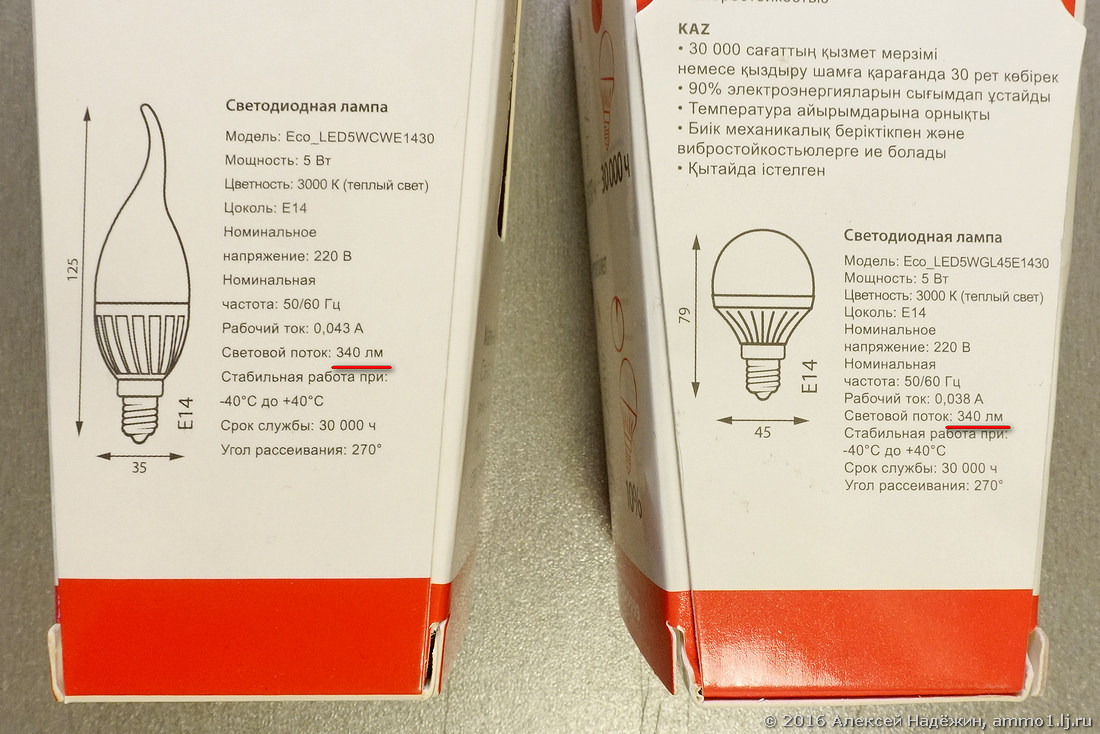
Only 340 lumens are not 60 W equivalent, but only 40. But this is not all deception. We test both lamps.

Instead of the promised 5 W, the power of the “candle” is 4 W, while the “ball” has only 3.9 W. Luminous flux - 283 and 231 lm. These bulbs shine like 25 watt incandescent bulbs, and the manufacturer promised the equivalent of 60 watts.
Another example is two Cosmos lamps. The manufacturer promises the equivalent of 75 W in a 7-watt bulb and 60 W in a 5-watt candle.
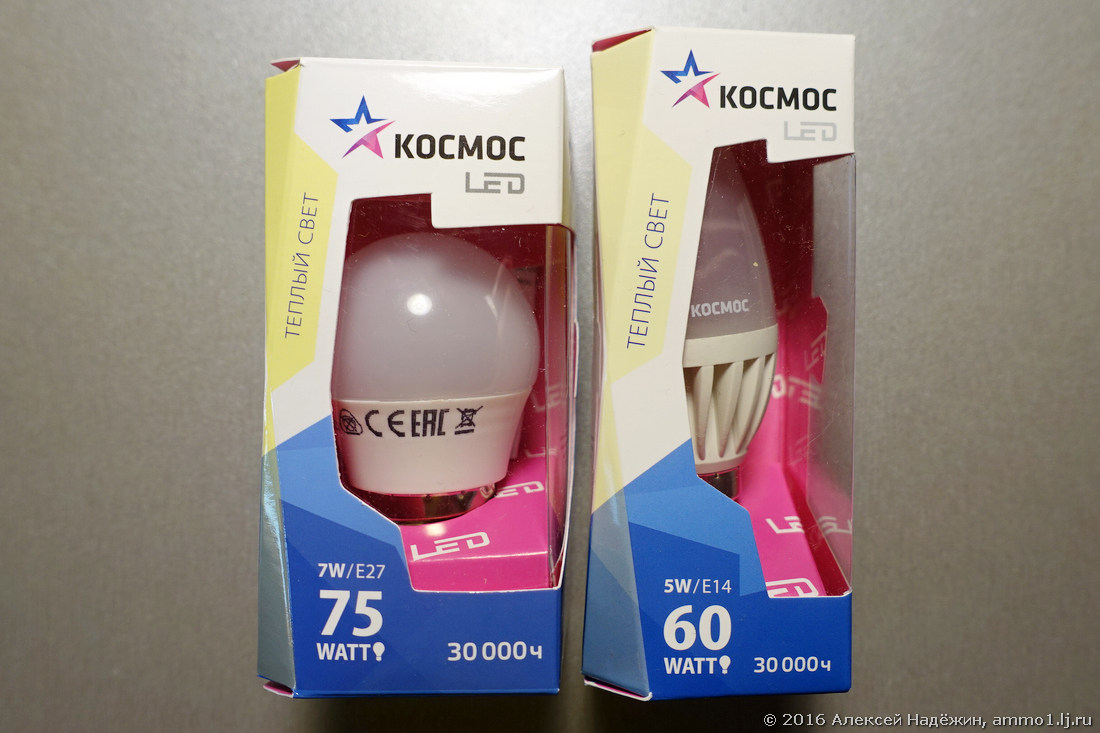
Already implausible, is not it? We look very small font on the back of the box.
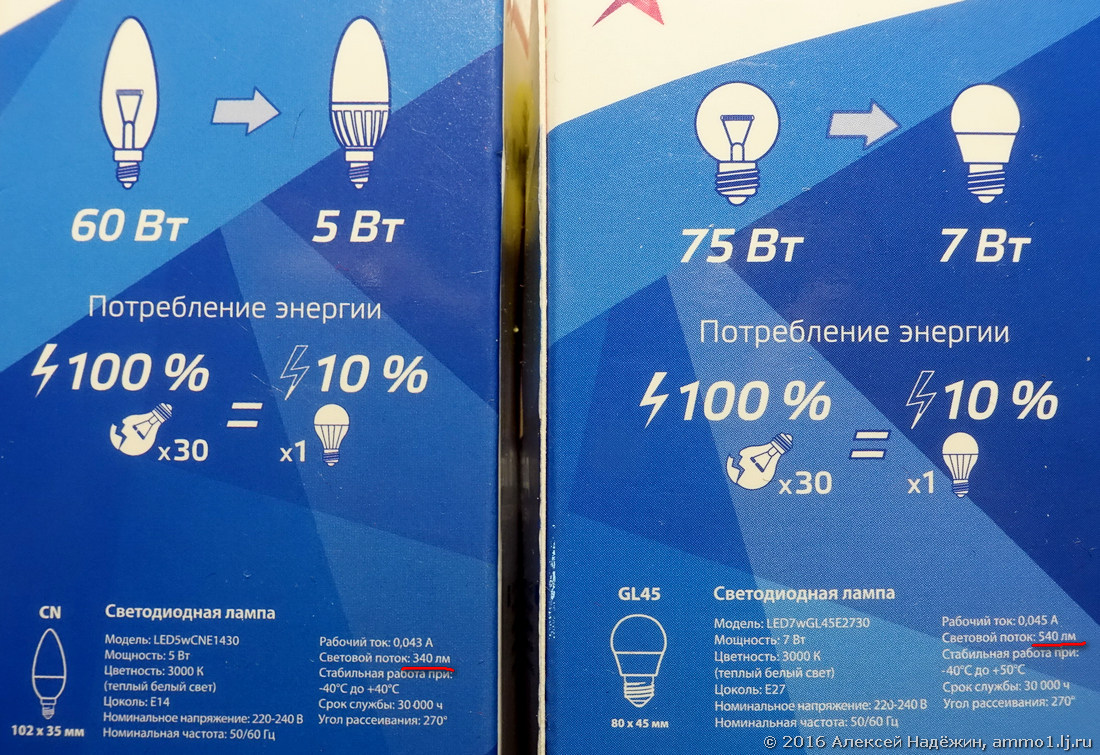
Candle - 340 Lm (in fact it is equivalent to 40 W), the ball - 540 Lm (equivalent to 60 W). Lied already on the box. We measure.
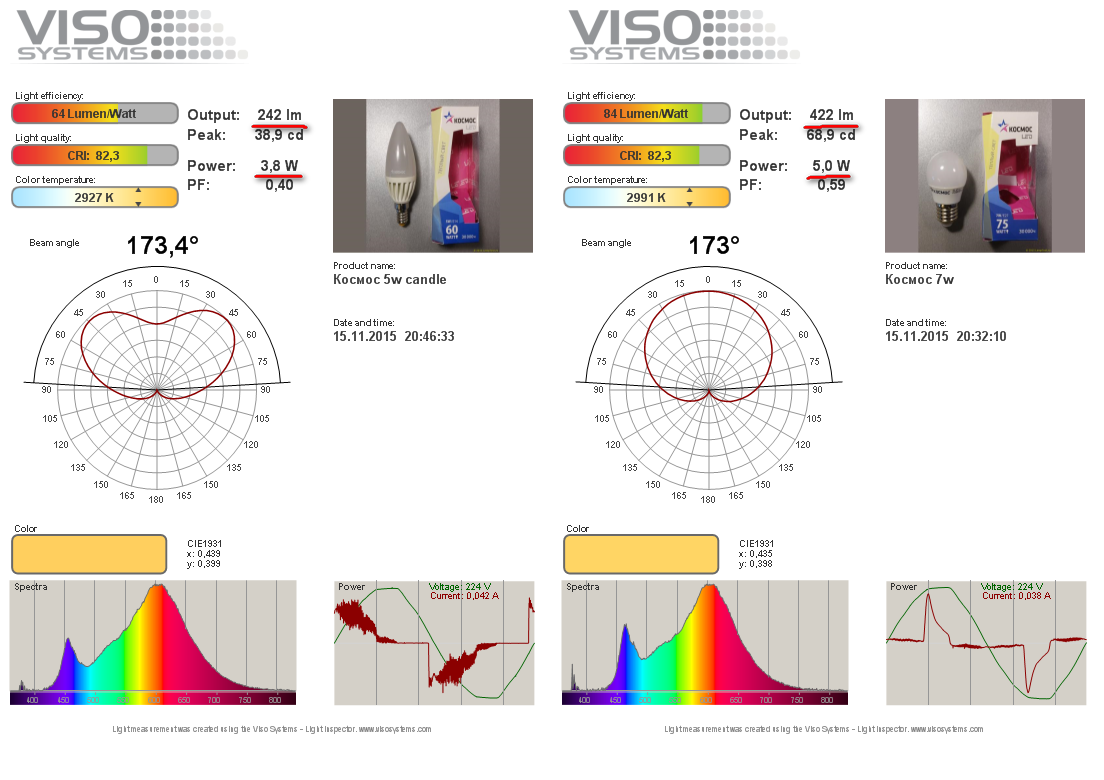
Candle power 3.8 watts instead of 5 watts. Power ball 5 watts instead of 7 watts. The luminous flux of a candle is only 242 Lm, at a ball - 422 Lm. They promised that the light bulbs will shine like 75 W and 60 W, and in fact they shine like 45 W and 25 W.
Sometimes, manufacturers cheat differently. Here is the lamp Start. The package shows 7 watts, the equivalent of 60 watts, 560 lm.

560 Lm really corresponds to the equivalent of 60 W (apparently, therefore, the manufacturer placed this inscription on the front of the box and wrote it in large print). We measure.
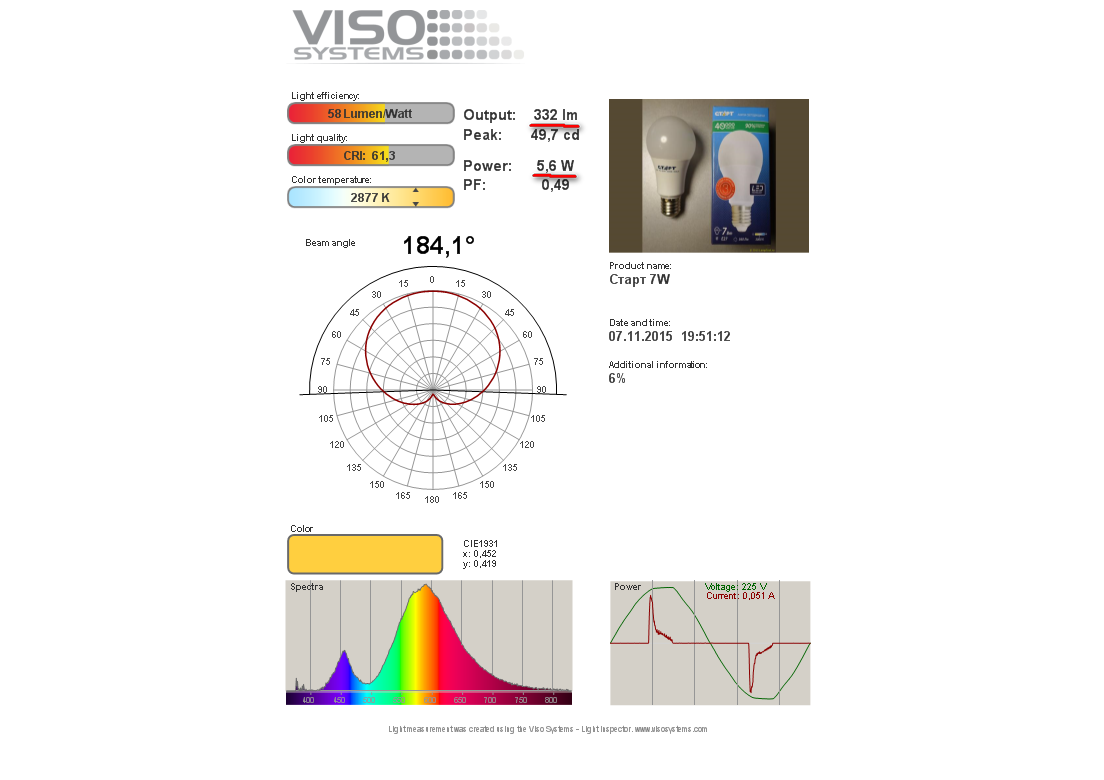
Oops. Instead of 7 W, only 5.6 W, and instead of 560 Lm, only 332 Lm. The light bulb, which according to the manufacturer’s assurances should shine like a 60-watt incandescent bulb, shines like a 40-watt bulb.
Unfortunately, in Russia, LED lamps are not controlled at all. According to GOST R 54815-2011, the measured initial luminous flux of an LED lamp must be at least 90% of the nominal luminous flux. But many simply spit on GOST.
Lying with power and brightness is not all. A large number of lamps with strong visible light pulsation (this can lead to fatigue), as well as lamps with a low color rendering index (CRI) can be found on sale, which makes the colors of objects illuminated by such lamps look unnatural.
I know only five brands that never lie with power and luminous flux. And they are not Russian. These are Ikea, Osram, Philips, Thomson and Diall (own brand of Castorama stores).
Most of the lamps of the Russian brands Navigator, Nanosvet, Lisma, Gauss, X-Flash have the power and the luminous flux corresponding to the declared ones and only some models of the lamps of these manufacturers shine weaker than promised. It is easy to explain - the lamps (and Lisma LED threads for the production of lamps) they order in China, and the Chinese manufacturers first supply the lamps corresponding to the pre-production samples, and then start saving and cheating their partners and us, the consumers. Equipment for testing lamps is expensive, tests in laboratories are also not cheap, so it turns out that manufacturers sometimes find out how much light their lamps actually give from me.
Before buying LED lamps, study the results of their testing on lamptest.ru. Even if there is not a specific model that you want to buy, you can form a general opinion about the manufacturer using other models. Often the lamp manufacturer is quite good, but you need to introduce a "correction for brightness", buying a lamp with a margin of brightness. For example, for the same brands Housekeeper, Cosmos and Start, many lamps are quite decent.
Do not be fooled!
Here are two lamps "housekeeper." Judging by the pictures, the buyer should understand that they consume 5 watts, and shine like 60-watt incandescent bulbs.

')
Cheating begins already in the information on the package. On both lamps in small print it is indicated: “Luminous flux: 340 lm”.

Only 340 lumens are not 60 W equivalent, but only 40. But this is not all deception. We test both lamps.

Instead of the promised 5 W, the power of the “candle” is 4 W, while the “ball” has only 3.9 W. Luminous flux - 283 and 231 lm. These bulbs shine like 25 watt incandescent bulbs, and the manufacturer promised the equivalent of 60 watts.
Another example is two Cosmos lamps. The manufacturer promises the equivalent of 75 W in a 7-watt bulb and 60 W in a 5-watt candle.

Already implausible, is not it? We look very small font on the back of the box.

Candle - 340 Lm (in fact it is equivalent to 40 W), the ball - 540 Lm (equivalent to 60 W). Lied already on the box. We measure.

Candle power 3.8 watts instead of 5 watts. Power ball 5 watts instead of 7 watts. The luminous flux of a candle is only 242 Lm, at a ball - 422 Lm. They promised that the light bulbs will shine like 75 W and 60 W, and in fact they shine like 45 W and 25 W.
Sometimes, manufacturers cheat differently. Here is the lamp Start. The package shows 7 watts, the equivalent of 60 watts, 560 lm.

560 Lm really corresponds to the equivalent of 60 W (apparently, therefore, the manufacturer placed this inscription on the front of the box and wrote it in large print). We measure.

Oops. Instead of 7 W, only 5.6 W, and instead of 560 Lm, only 332 Lm. The light bulb, which according to the manufacturer’s assurances should shine like a 60-watt incandescent bulb, shines like a 40-watt bulb.
Unfortunately, in Russia, LED lamps are not controlled at all. According to GOST R 54815-2011, the measured initial luminous flux of an LED lamp must be at least 90% of the nominal luminous flux. But many simply spit on GOST.
Lying with power and brightness is not all. A large number of lamps with strong visible light pulsation (this can lead to fatigue), as well as lamps with a low color rendering index (CRI) can be found on sale, which makes the colors of objects illuminated by such lamps look unnatural.
I know only five brands that never lie with power and luminous flux. And they are not Russian. These are Ikea, Osram, Philips, Thomson and Diall (own brand of Castorama stores).
Most of the lamps of the Russian brands Navigator, Nanosvet, Lisma, Gauss, X-Flash have the power and the luminous flux corresponding to the declared ones and only some models of the lamps of these manufacturers shine weaker than promised. It is easy to explain - the lamps (and Lisma LED threads for the production of lamps) they order in China, and the Chinese manufacturers first supply the lamps corresponding to the pre-production samples, and then start saving and cheating their partners and us, the consumers. Equipment for testing lamps is expensive, tests in laboratories are also not cheap, so it turns out that manufacturers sometimes find out how much light their lamps actually give from me.
Before buying LED lamps, study the results of their testing on lamptest.ru. Even if there is not a specific model that you want to buy, you can form a general opinion about the manufacturer using other models. Often the lamp manufacturer is quite good, but you need to introduce a "correction for brightness", buying a lamp with a margin of brightness. For example, for the same brands Housekeeper, Cosmos and Start, many lamps are quite decent.
Do not be fooled!
Source: https://habr.com/ru/post/371797/
All Articles